#patent application
Explore tagged Tumblr posts
Text
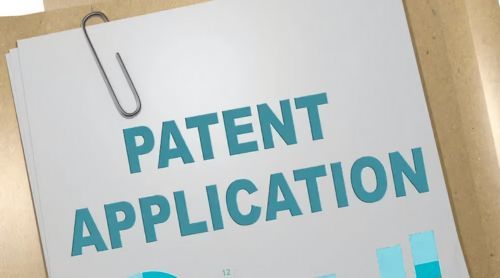
Secure Your Innovation – Patent Application Services | Einfolge Technologies
Einfolge Technologies offers comprehensive patent application services to help innovators secure legal protection for their inventions. Our team guides you through every step—from drafting and documentation to filing with national and international patent offices. With deep expertise in various industries and jurisdictions, we ensure your application is complete, compliant, and strategically aligned. Whether filing in India or globally, Einfolge simplifies the patent process with precision and speed.
0 notes
Text
Step-by-Step Guide to the Patent Filing Process: What You Need to Know

Filing for a patent may seem overwhelming, but breaking it down into steps can make the process clearer. Here’s a step-by-step guide to patent filing, and why a patent attorney Bradenton, FL can help at each stage:
Document Your Invention: Keep detailed records of your invention, including drawings, descriptions, and dates of development.
Conduct a Patent Search: Before filing, a patent attorney will conduct a search to ensure your invention hasn’t been patented before.
Prepare Your Patent Application: This is the most complex step. Your patent attorney Bradenton, FL will help prepare the application, ensuring all claims are clearly defined and meet the legal criteria.
Submit the Application: After preparation, your attorney will file the application with the U.S. Patent and Trademark Office (USPTO).
Examination Process: The USPTO will examine the application. Your patent attorney Bradenton, FL will work with the examiner to address any issues or objections that may arise.
Granting of Patent: Once approved, your patent will be granted, and your attorney will ensure that all legal rights are enforced.
A patent attorney Bradenton, FL can handle the entire process with expertise, ensuring that your patent is filed correctly, saving you time and reducing potential errors.
Need help with patent filing? Contact Grivas Law, your trusted patent attorney Bradenton, FL.
0 notes
Text
3D vs 2D Design Patent Illustrations — Which One Should You Use? | The Patent Experts
Introduction
Design is more than just aesthetics — it’s an identity, a selling point, and sometimes, a competitive edge. That’s why securing a design patent is crucial for inventors, startups, and even established brands. But here’s the kicker: a design patent isn’t just about what your product looks like — it’s about how you show what it looks like.
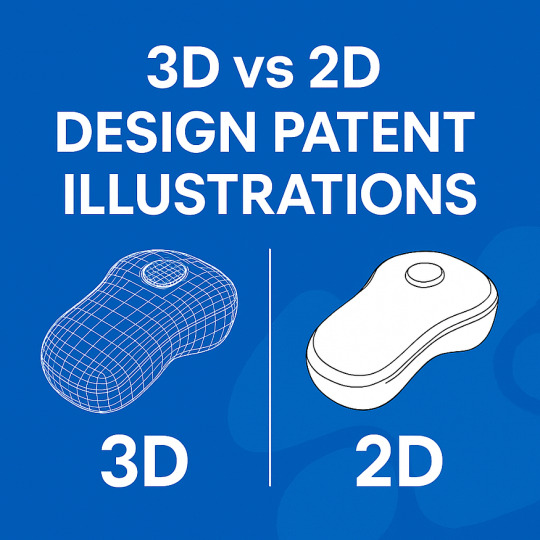
If you’re on the fence about whether to go with traditional 2D drawings or high-tech 3D renders, this blog breaks it all down. We’ll go deep into the pros, cons, use cases, and real-world insights so you can make the smartest move for your patent strategy.
What Is a Design Patent?
A design patent protects the ornamental appearance of a product. Unlike utility patents, which safeguard how something works, design patents focus solely on how something looks.
Let’s say you invented a uniquely curved smartphone or a stylish kitchen gadget. You can’t patent the function (unless it’s new), but you can protect its visual features — its curves, edges, and shape.
But here’s the catch: your application has to visually describe the design in minute detail, leaving no room for misinterpretation. And that means your illustrations need to be on point.
Why Are Patent Illustrations So Critical?
Patent examiners don’t guess. They evaluate exactly what’s shown in your illustrations. These drawings:
Define the scope of your protection
Get referenced in court, if needed
Are compared against prior designs
If your illustrations miss a line or show something unclear? Boom — your application could get rejected or your patent could be challenged later.
So yeah, getting the illustrations right is mission-critical.
What Are 2D Design Patent Illustrations?
2D patent illustrations are the traditional, go-to format. These are flat, orthographic views — think top, bottom, front, back, left, right, and isometric (optional).
Each view is like a piece of a puzzle. Together, they form a complete picture of the object.
Benefits of 2D Illustrations
Cost-effective for simple designs
Faster turnaround times
Easier to revise for basic geometry
Meets USPTO guidelines when done right
Limitations of 2D Illustrations
Doesn’t capture depth or complex curvature well
Can be confusing for organically shaped products
Requires multiple views to convey full shape
Can lead to inconsistent line weights if drawn manually
Example
Imagine you’re patenting a rectangular tissue box. A 2D drawing can handle this easily. Six clean, orthographic views and you’re good to go.
But now imagine you’ve designed a sleek new gaming mouse with complex curves and textured surfaces. That’s where 2D might fall short.
What Are 3D Design Patent Illustrations?
3D design patent illustrations are perspective views created from a digital model. These offer depth, dimensionality, and a far more realistic view of the product.
The 3D model is created using CAD (Computer-Aided Design) software, then static images of different views are extracted and refined for submission.
Advantages of 3D Illustrations
Easier to understand complex shapes and textures
Excellent for curved or intricate designs
More consistent views (all from the same model)
Reusable for marketing, prototyping, and 3D printing
Drawbacks
Higher cost due to modeling time
Requires advanced software and skill
Longer turnaround for detailed models
Must be converted to USPTO-compliant 2D format
Real-World Case Study
A startup designing ergonomic headphones used 3D illustrations to show the contour, foldability, and integration of buttons. Their initial 2D submission was flagged for unclear views. After switching to 3D-rendered outputs, the USPTO accepted the drawings, and their patent was granted within six months.
When Should You Use 2D vs 3D?
Choosing between 2D and 3D comes down to:
Design complexity
Your budget
USPTO compliance
Go with 2D if:
Your design is flat or symmetrical
You want to save money and time
Your product looks similar from most angles
Go with 3D if:
Your design is complex or curved
You want highly detailed, realistic visuals
You need consistency across multiple angles
In many cases, applicants use a hybrid strategy: creating a 3D model and extracting 2D-compliant illustrations from it.
USPTO’s Stance on 2D and 3D
The USPTO doesn’t show favoritism between 2D and 3D illustrations, as long as the drawings:
Accurately represent the design
Maintain consistency across views
Follow black-and-white format (no colors or photos)
Include proper shading, line weights, and view labels
That said, perspective views (often created from 3D models) are optional but recommended for designs with unique contours.
How Much Do Design Patent Illustrations Cost?
Let’s talk numbers.
2D Illustrations
Average Cost: $100 — $300
Good for: Straightforward, geometric designs
3D Illustrations
Average Cost: $300 — $800+
Good for: Complex shapes, consumer electronics, fashion accessories
The price can vary based on:
Number of views required
Revisions requested
Level of detail
Whether you already have a CAD model
Turnaround Time: How Long Does It Take?
Speed matters, especially if you’re in a race to file.
2D Turnaround: 2–5 business days
3D Turnaround: 4–10 business days
With 3D, you might spend more time upfront modeling, but view generation and revisions are easier once the base model is done.
Why Getting It Wrong Can Cost You Big
Submitting poor-quality or non-compliant illustrations can:
Delay your application
Result in USPTO objections
Lead to narrower protection than intended
Increase legal costs if challenged later
We’ve seen clients come to professional services after wasting time and money on DIY attempts. Don’t be that person.
How Professionals Help (and Save You Headaches)
Professional illustrators:
Know the USPTO’s rules inside out
Use advanced tools like SolidWorks, Rhino, or Adobe Illustrator
Create clean, consistent, and legally defensible visuals
Advise you on optimal view angles
They also prevent common pitfalls like:
Misaligned views
Inconsistent shading
Improper line weights
Missing views
Industry Examples
Consumer Products
Think toothbrushes, bottles, headphones. These often have subtle curves and textures — 3D is often the winner here.
Fashion Accessories
Sunglasses, bags, and jewelry require fine details and texture — a 3D model can show folds, stitching, and curves much more effectively.
Mechanical Components
2D may be enough for bolts, brackets, and flat parts. But for ergonomic tools or curved assemblies? 3D takes the cake.
Additional Insights: Legal Perspective
In IP litigation, your patent drawings may be scrutinized in court. Any ambiguity in design may weaken your case.
3D-rendered outputs, when properly converted, reduce ambiguity and provide clearer intent. This can be a critical factor in defending your rights.
Conclusion
In the battle of 3D vs. 2D design patent illustrations, there’s no one-size-fits-all answer.
If your product is simple and budget is tight, go with 2D. But if your design has curves, contours, or complex geometry, 3D is the smarter investment.
Remember, your illustrations define your patent rights — don’t cut corners here.
Looking for expert help? At The Patent Experts, we offer USPTO-compliant 2D and 3D design patent illustration services tailored to your exact needs. Whether you need high-detail 3D renderings or quick 2D sketches, our team ensures precision, speed, and compliance.
Get your design patent drawings done right
FAQs
1. Can I submit both 2D and 3D illustrations in one application? Yes, as long as they are consistent. Most applicants use 3D models to create 2D views for submission.
2. Does using 3D improve my chances of getting a patent? Not directly, but clearer visuals reduce misunderstandings and office actions, speeding up approval.
3. What file format should I submit to the USPTO? Submit static black-and-white images in PDF or TIFF format. Vector files or raw 3D models aren’t accepted.
4. Can I use photos instead of drawings? Generally, no. Photos are not accepted unless the object cannot be illustrated with line drawings, which is rare.
5. What happens if my drawings aren’t compliant? Your application may be rejected or delayed until you fix the drawings. Non-compliant illustrations can also weaken your patent rights.
#design patent illustration services#design patent drawings#patent illustrations#patent drawings#uspto#patent application#patent drafting#cad drawings#machine drawings#design patent drawing requirements#design patent drawing examples#uspto compliant drawings#professional patent drawings#utility vs design patents
0 notes
Text
0 notes
Text
Experienced and Professional Patent Illustrators - Digital Suntech
When it comes to patent drawings, experienced and professional patent illustrators at Digital Suntech stand as the first choice for innovators and businesses. Our team is dedicated to producing meticulously crafted illustrations that not only meet stringent USPTO guidelines but also capture the essence of your invention with precision and clarity. With a proven track record across various industries, our expertise ensures that your patent drawings are accurate, detailed, and tailored to enhance the strength of your patent application. Choose Digital Suntech for patent illustration services that combine technical proficiency with a deep understanding of the patent process, ensuring your intellectual property is well-protected and effectively communicated.

#patent illustration#patent drawings#patent application#intellectual property#innovation#patent illustrators#digital suntech
0 notes
Text
What are the essential key steps to register a Patent for a new invention ?

Registering a patent for a new invention involves several key steps:
Step 1: Patent Search Report
Prior to submitting the patent application, the inventor is required to perform a patent search report. This search report reduces the likelihood of infringement and helps to ensure the novelty of the creation or idea.
Step 2: Patent Application Filing
After conducting a search report and knowing the novelty, the next step is filing a Patent application. The applicant has to fill out some forms that are as follows:
Form 1: This form contains 5 pages that pertain to all the personal details of the applicant/ applicants.
Form 2: In this form, the applicant has to describe all about the invention or creation. The description should be detailed which helps the examiner to get clear information regarding creation.
To meet the requirements, an additional form must be submitted.
Step 3: Patent Journal
The patent is sent to the patent journal upon filing of the patent application. It aids in announcing the discovery to the public and starting the opposition phase. If a third party has any concerns about the applied patent during this window, they may submit an opposition. An opposition period promotes a fair and competitive environment for intellectual property by ensuring that only truly inventive and deserving innovations acquire patents. It also provides transparency.
Step 4: Examination
The opposition window is closed, and then the examination process begins. Here, the patent examiner verifies whether or not the requirements of that patent are fulfilled. Additionally, they verify the patentability, novelty, and originality. Should the examiner discover any discrepancies with the applicant-provided criteria, they have the option to submit an objection.
Step 5: Grant or Refuse
The patent office will make a determination regarding the acceptance or rejection of the patent application following the conclusion of the examination procedure and the resolution of any objections. If the patent is approved, the inventor will be granted exclusive rights to the innovation for a predetermined amount of time, usually 20 years from the date of application. In the event that the application is rejected, the inventor might be able to file an appeal or fix any errors by amending it.
#legal services#legal advice#law firm#legal assistance#patent registration#patent application#patent services#patent#intellectual property#patent search
0 notes
Text
PCT Patent Application - Affordable Patent Agency Streamline your PCT patent application with Affordable Patent Agency. Our Texas-based experts provide efficient and cost-effective international patent filing services. Protect your inventions globally with ease!
0 notes
Text
Digital Suntech offers top-tier patent drawing services, providing precise and professional patent illustrations that meet USPTO, EPO, and PCT standards. Our team of skilled illustrators utilizes the latest digital tools to create detailed, accurate drawings that enhance your patent applications. With a focus on clarity and precision, Digital Suntech ensures that each illustration effectively communicates the technical details of your invention, aiding in a smoother patent approval process. Trust Digital Suntech for all your patent drawing needs, and experience the benefits of expert craftsmanship and exceptional service.
#patent drawing services#patent illustrations#intellectual property#patent attorney#digital suntech#patent application#patent drawing#patent illustrators
0 notes
Text
Patent Illustrations and Drawings - Digital Suntech
Are you in search of top-notch patent illustrations and drawings that not only meet but exceed industry standards? Look no further than Digital Suntech! As the frontrunner in this niche, we take pride in offering unparalleled services that cater to the diverse needs of inventors, patent attorneys, law firms, and businesses worldwide.
Join the ranks of satisfied clients who have entrusted their patent illustration needs to Digital Suntech. Experience the difference today!
Get in touch with us to learn more about our services and how we can assist you in bringing your innovations to life with our stellar patent illustrations and drawings. Your success is our priority!
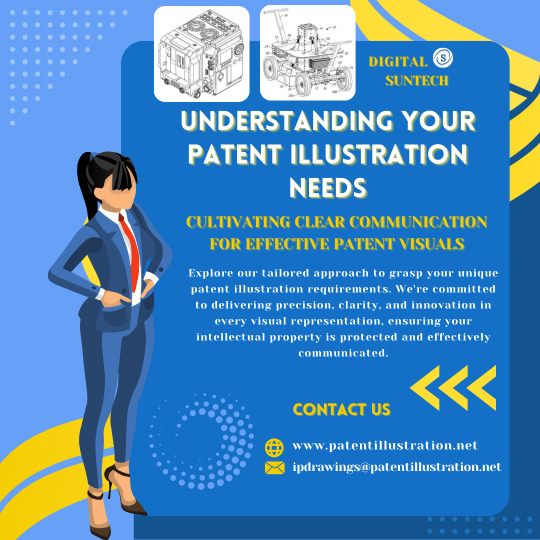
Visit official website: https://patentillustration.net/patent-illustration-services-way-to-a-flawless-patent-application
#patent drawings#patent illustrations#intellectual property#digital suntech#patent application#patent drawing services#patent illustration services#patent attorneys
0 notes
Text
What exactly are patent illustrations, and why are they so important?
In the dynamic world of intellectual property, patent illustrations play a crucial role in conveying complex innovations visually. These illustrations, often referred to as patent drawings or figures, are visual representations accompanying a patent application. But what exactly are patent illustrations, and why are they so important?

What are Patent Illustrations?
Patent illustrations are detailed visual depictions of an invention submitted alongside the written description in a patent application. These drawings are designed to complement the technical details in the application, providing a comprehensive and clear understanding of the invention. They serve as a universal language that transcends linguistic barriers, aiding patent examiners, inventors, and the public in grasping the essence of a novel idea.

The Key Components of Patent Illustrations:
Clarity and Detail: Patent drawings must be clear, concise, and sufficiently detailed to represent the invention accurately. Each element should be labeled and accompanied by reference numerals to correlate with the written description.
Technical Accuracy: Precision is paramount. Patent illustrations should adhere to the specific rules and guidelines set by the patent office, ensuring technical accuracy and compliance with industry standards.
Different Views: Depending on the complexity of the invention, patent illustrations may include various views such as perspective views, cross-sectional views, exploded views, and more. These different perspectives help convey the invention comprehensively.
The Use and Importance of Patent Illustrations:
Enhancing Understanding: Patent illustrations provide a visual aid that enhances the understanding of the invention, making it easier for patent examiners to assess the uniqueness and novelty of the idea.
Global Communication: In the global landscape of innovation, patent illustrations serve as a universal language. They enable inventors and stakeholders worldwide to comprehend the essence of an invention without relying solely on textual descriptions.
Legal Protection: Patent illustrations are integral to the patent application process. They contribute to the legal protection of an invention by offering a detailed visual representation that strengthens the claims made in the written description.
Facilitating Examination: Patent examiners rely on illustrations to efficiently evaluate the technical aspects of an invention. Well-crafted illustrations streamline the examination process, potentially expediting the patent approval timeline.

In conclusion, patent illustrations are not just drawings; they are indispensable tools in the realm of intellectual property. They bridge the gap between innovative ideas and their legal protection, providing a visual narrative that transcends boundaries and propels the progress of technology and innovation. As inventors navigate the intricate path of patent applications, the artistry and precision of patent illustrations become invaluable allies in securing a brighter future for groundbreaking ideas.
#patent illustration#patent drawings#digital suntech#intellectual property#what are patent illustrations#importance of patent illustrations#patent application
1 note
·
View note
Text

Patent Act Essentials for Innovators and Enterprises | Einfolge Technologies
Einfolge Technologies provides expert insights and advisory services on the Patent Act to help innovators, businesses, and legal professionals navigate the complexities of patent law. Our team interprets key provisions, filing requirements, and compliance obligations under national and international patent acts. We support strategic IP decisions, ensure legal alignment, and empower clients with the knowledge needed to protect and enforce their patent rights effectively.
#patent#patent search#patent services#patent process#patent act#patent application#einfolge technologies
0 notes
Text
In the present scenario it can also be observed that big labels who are licensing their catalogues have resorted to new and improved ways of sharing copyright data to streaming services
0 notes
Text
Design Patent Illustration Services | USPTO-Compliant Drawings | The Patent Experts
Design Patent Illustration Services by The Patent Experts deliver precise, USPTO-compliant design patent drawings tailored to meet all design patent drawing requirements. Our expert team specializes in patent illustrations that clearly depict your invention, ensuring a smooth patent application process.
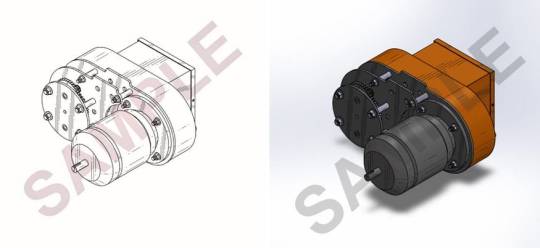
With years of experience in patent drafting, we create detailed CAD drawings, machine drawings, and line art that conform to the USPTO’s strict standards. Our portfolio includes numerous design patent drawing examples, showing our commitment to accuracy and quality.
Whether you’re an inventor, entrepreneur, or attorney, trust us to produce high-quality patent drawings that support your IP strategy. Order professional design patent drawings now at www.thepatentexperts.com/service/design-patent-drawings/3
#design patent illustration services#design patent drawings#patent illustrations#patent drawings#uspto#patent application#patent drafting#cad drawings#machine drawings#design patent drawing requirements#design patent drawing examples#uspto compliant drawings#professional patent drawings#utility vs design patents
0 notes
Text
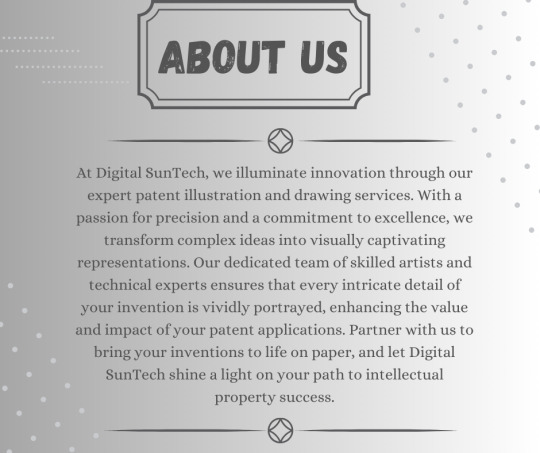
Introducing Digital SunTech, a cutting-edge patent portfolio by our talented team of patent illustrators. Our innovative digital solutions redefine the landscape of patent illustrations, seamlessly blending artistic precision with technological excellence. From intricate designs to detailed schematics, Digital SunTech ensures clarity and sophistication in every visual representation. Elevate your intellectual property with our state-of-the-art digital illustrations, setting your patents apart in the competitive market. Trust in our expertise to bring your ideas to life visually, fostering a stronger, more comprehensive patent portfolio. Explore the future of patent illustration with Digital SunTech – where precision meets innovation.
#patent illustrators#patent drawings#patent application#patent drawing services#patent illustration#patent attorney#patent registration
0 notes
Text
Mechanical Drawings | Mechanical Patent Drawings | Digital Suntech

At Digital Suntech, we specialize in creating precise and detailed mechanical patent drawings that meet the stringent requirements of patent offices worldwide. Our expert team employs advanced CAD software to meticulously draft each component, ensuring clarity and accuracy that effectively conveys the inventive aspects of your design. Whether it's for a new mechanical device or an innovative engineering solution, our patent drawings enhance the overall quality of your patent application, helping to secure your intellectual property with the highest professional standards. Trust Digital Suntech for reliable, high-quality mechanical patent illustrations that protect your innovations.
#patent drawings#patent application#intellectual property#mechanical patent drawings#digital suntech#innovation
0 notes
Text
What is the difference between a Utility Patent and a Plant Patent in Intellectual Property?
In Intellectual property law, Utility Patent and Plant Patent serve to protect different types of inventions and discoveries. Here’s a detailed comparison of the two:
Utility Patent
Definition:
A utility patent protects new and useful processes, machines, articles of manufacture, compositions of matter, or any new and useful improvement thereof.
Scope:
Covers a wide range of inventions, including mechanical devices, electrical circuits, chemical compositions, software, business methods, and more.
Requirements:
The invention must be novel, non-obvious, and useful.
Detailed description of the invention is required, including how to make and use it.
Duration:
Typically lasts for 20 years from the filing date of the patent application.
Examples:
A new type of engine, a pharmaceutical drug, a software algorithm, a household appliance, etc.
Plant Patent
Definition:
A plant patent protects new and distinct varieties of plants that are asexually reproduced.
Scope:
Specifically limited to new plant varieties that are asexually reproduced, meaning the plant must be reproduced by means other than seeds, such as by grafting, cutting, layering, or other non-sexual methods.
Requirements:
The plant must be novel and distinct from known varieties.
The plant must be capable of asexual reproduction, ensuring that the new variety can be reliably reproduced.
Duration:
Typically lasts for 20 years from the filing date of the patent application.
Examples:
A new variety of rose, an apple tree with unique characteristics, a distinct type of succulent, etc.
Key Differences
Type of Invention:
Utility patents cover a broad range of inventions and improvements across various fields.
Plant patents are specifically for new plant varieties reproduced asexually.
Reproduction:
Plant patents require the plant to be reproduced asexually to ensure the distinct characteristics are consistently replicated.
Utility patents do not have such a requirement.
Content and Claims:
Utility patents require a detailed description and claims that define the scope of the invention.
Plant patents require a detailed botanical description and a declaration of the new and distinct characteristics of the plant.
Complexity and Application:
Utility patent applications are generally more complex and extensive, involving claims, drawings, and specifications.
Plant patent applications focus more on the detailed botanical description and evidence of the plant's distinctiveness and asexual reproduction capability.
In summary, while utility patents provide broad protection for a wide array of inventions, plant patents are specialized for protecting new plant varieties reproduced asexually. Each type of patent has distinct requirements and serves different purposes in the realm of intellectual property.
#legal services#legal advice#law firm#patent registration#patent services#patent application#patent#legal help#legal assistance#business#legal advisory services#services#inventions
0 notes